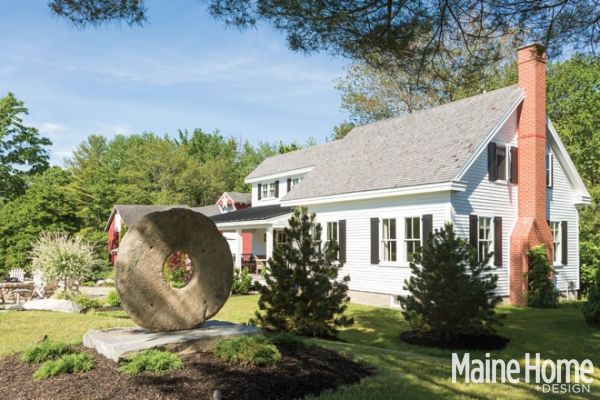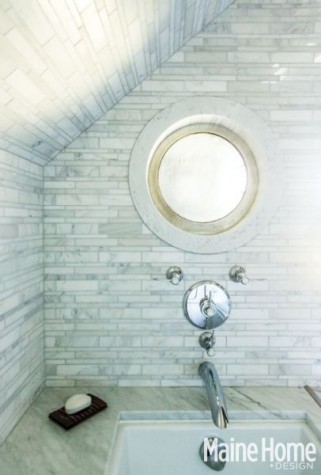Farmhouse Eclectic
A Bahamas hotelier designs a wholly original house on a former dairy farm in Kennebunk
Don Purdy had been in Kennebunk for less than a day when he decided to buy a house. Actually, it was more like five minutes. From the start, the area felt “familiar to me,” he says, which might be a surprise, given that Purdy spends most of the year in the Bahamas, on Harbour Island, where he owns and runs Rock House, a boutique hotel frequented by celebrity clients such as Jack Nicholson and Elle Macpherson. Before that, he worked in the Miami Beach design and construction business of his late partner, J. Wallace Tutt III, known for building Gianni Versace’s South Beach house, as well as a Malibu house for Cher that recently sold to Beyoncé for $40 million. Those aren’t exactly the names one most associates with the Kennebunks. But Purdy is from Canada, so Maine’s landscape was recognizable to him. Plus, on his first visit to Kennebunk—as a guest of Chicago friends with a beach house—he went to the Ramp, a local and popular lobster-buoy-festooned restaurant. Immediately, guests from his Bahamas hotel walked in. Purdy’s friend developer Tim Harrington—who summers in the Kennebunks but crosses paths with Purdy in Miami Beach—was another familiar face.
Unfortunately, the process of finding the right house didn’t go as quickly as the decision to buy. A few years passed before Purdy and his sister, Donna Macris, bought a farmhouse on a former dairy farm. Macris, a nurse who was living in Houston, had decided to relocate to Kennebunk. The plan was that she’d live in the house year-round and Purdy would come for the three summer months.
Because the house had been fully renovated in the relatively recent past, Purdy wasn’t thinking of a major redo when he bought the house. He was just going to “fluff it up,” he says, with a new kitchen and bathrooms. But when the builder, Susan Smith of DJS Building and Restoration in Kennebunk, started tearing down walls, Purdy so admired the bones of the house that he could see new possibilities. He started to reconceive the space. In the end, three upstairs bedrooms and accompanying baths got reconfigured into two owners’ bedroom suites with separate staircases to suit the way Purdy and Macris were going to live in the house. A blocky chimney was removed so, on the ground floor, a kitchen and dining room could be combined into an L-shaped central room and, on the second floor, Purdy’s bedroom could be fit into a space that was further expanded by removing the ceiling to incorporate the attic area.
“I like surprises,” says Purdy, and whenever people told him that what he was doing wasn’t typically done in Maine, he made it clear that that was the point. He wanted to do something outside the box. And he succeeded. The house feels wholly original in its eclectic combination of textures, materials, objects, art, lighting, and furniture, all of which often have their own surprising stories.
Take, for instance, the dining room chandelier. Purdy found a drum of the sort of grating that is commonly used in commercial garage fencing and used it as the surround for an antique chandelier, in which he replaced the original crystal with more stylish quartz ornaments. Rather than simply hang this from the ceiling, Purdy had Steve Hanson of Hanson Woodturning in Cape Porpoise make a ceiling medallion of the same silvery, aged barnwood used for the kitchen island as well as the dining room wainscoting and kitchen/dining room beams. Mason Ben Cable of Kennebunkport then surrounded the medallion with the brick that Purdy chose for a kitchen/dining room wall and for the stove backsplash. It’s safe to say no one else has ever combined these materials and items in exactly this way before.
Another example: the powder room. Purdy had heard that the original owner of the house was a penny-pincher who never had a bathroom inside his farmhouse, so Purdy decided his powder room would have weather-beaten walls that would look like outhouse walls, an idea that his friends and family did not particularly celebrate. Purdy told them to wait and see the final effect; he was going to combine the raw wood with artwork: a Picasso lithograph, a Rembrandt stamped copy, and a Diego Rivera lithograph. Then he added a custom vanity, an eighteenth-century Venetian mirror that looks like it might have come out of a palazzo, and a ceiling light made from the cage of an old-fashioned oscillating fan. Now when Purdy has parties, friends and children like to go to the bathroom to write on another object Purdy managed to incorporate into the room: a chalkboard from an old school.
Some of the surprises in the home are purely whimsical and take a little work to discover. For instance, the central kitchen/ dining room is separated from the living room by a wall faced in brick. Purdy wanted the appearance of exposed brick— something that would look like it had always been there—without the weight or thickness of actual brick, so he had DJS cut off the faces of the brick and use those for the wall. Two entries to the living room cut into the brick veneer, but there is also a third, secret door that leads to the basement. You can’t see it, but if you press the brick wall in just the right place, it pops open. There are more secret doors in the wainscoting of Purdy’s upstairs bedroom, and he’s planning an even more elaborate secret door for the vestibule of the house. There, a mirror framed in weathered wood and with the dimensions of an oversized door covers a wall that has been worked so that it can be reconfigured, at a later date, into a doorway leading to the barn. At the moment, the large red barn attached to the house is condemned because it has no foundation. Purdy eventually plans to tear down the barn and salvage the wood for a structure that will include a spa, gym, media room, billiard room, and guest rooms. When this plan is realized, the framed mirror will swing open when pressed, and there will be a secret passageway to the new rooms beyond.
Some of the fun of the home is in the number of objects that were originally something else: lamp bases formed out of balustrades, a 200-year- old granite well cap that has been put on a pedestal and turned into a giant outdoor sculpture, a ceiling lamp made out of an old meat scale, an antique wood ladder that is now a towel rack, and an oyster-shucking station with steel corners for ice that now serves as a bar. Purdy bought an old aluminum locker cage—the kind where the lockers are actually baskets that slide in and out of shelves—and uses that piece as a dresser for his bedroom closet, itself hidden behind a wardrobe. Also tucked away in the closet are two wooden figures that suggest votive statues. Divided lengthwise, they open to reveal wood interiors scooped out in the shape of a bottle. The figures were used by a troupe of nineteenth- century puppeteers to hide alcohol from authorities in Italy.
In addition to the one-of-a-kind pieces, Purdy has various collections. African masks in his bedroom. His late partner’s bronze sculptures, which include two pheasants in the vestibule and a duck-hunting dog on a living room table. Giant clamshells. Old wooden boxes. Jean-Claude Salomon paintings and Picasso prints.
Although Purdy went with local talent for the builder, he brought in an interior designer and architect with whom he’d frequently worked in his late partner’s business: Daniel Gomez of Daniel Gomez Architecture of Miami and interior designer Denise LaVey of Miami and Los Angeles. LaVey and Purdy went on a buying tour of New England antique shops, but many items and materials came from local vendors in Kennebunk. Lighting Guild in Saco was responsible for assembling and rewiring much of the lighting, and the cabinetmaker team of Matthew Kidwell, Derek Preble, and Jud Star in Biddeford built and designed much of the custom cabinetry, including the reclaimed oak kitchen cabinets with an espresso stain and a Mondrian- inspired vanity of mixed woods in the powder room.
Outside, Purdy collaborated with landscape designer Ted Carter of Buxton for a front yard with an extended bluestone terrace and a gas fire pit with a granite surround as a focal point. The front porch is furnished to suggest an outdoor dining room and living room. The sandalwood beachy color of its “rooms” extends to the palette of the interior, which tends to neutrals with muted blue accents, save for the paintings, where vibrant reds, blues, and yellows are amply represented.
Although in his work life Purdy has bought, renovated, and sold many properties, his Maine house is not one he plans to turn over. He means to retire to Maine and then live the rest of his life here. Ordinarily, Purdy says he is a “go go go” person, but Maine is the place where he comes to relax. He’s as smitten with the Kennebunk area as he was on his first visit, now five years ago. “It’s my Zen place,” he says. “I love it so much.”















